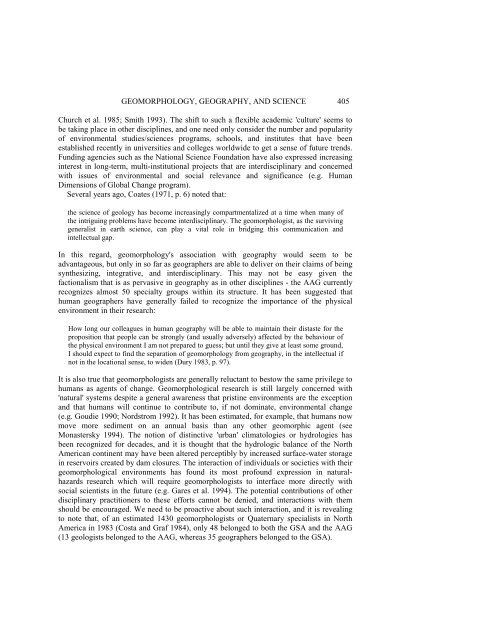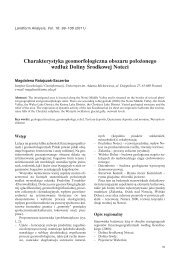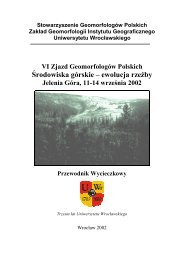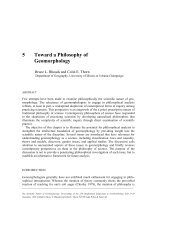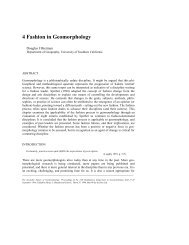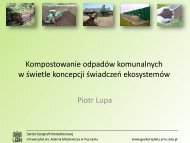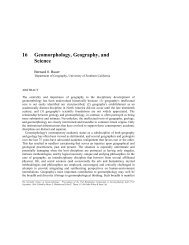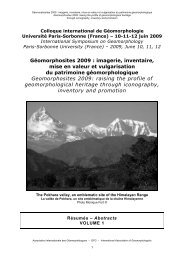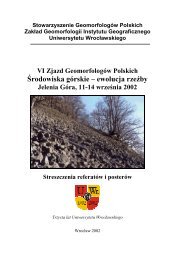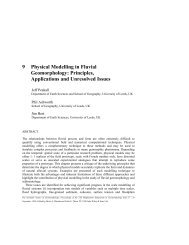Chapter 16 - Geomorphology, Geography, and Science Bernard 0
Chapter 16 - Geomorphology, Geography, and Science Bernard 0
Chapter 16 - Geomorphology, Geography, and Science Bernard 0
You also want an ePaper? Increase the reach of your titles
YUMPU automatically turns print PDFs into web optimized ePapers that Google loves.
GEOMORPHOLOGY, GEOGRAPHY, AND SCIENCE 405<br />
Church et al. 1985; Smith 1993). The shift to such a flexible academic 'culture' seems to<br />
be taking place in other disciplines, <strong>and</strong> one need only consider the number <strong>and</strong> popularity<br />
of environmental studies/sciences programs, schools, <strong>and</strong> institutes that have been<br />
established recently in universities <strong>and</strong> colleges worldwide to get a sense of future trends.<br />
Funding agencies such as the National <strong>Science</strong> Foundation have also expressed increasing<br />
interest in long-term, multi-institutional projects that are interdisciplinary <strong>and</strong> concerned<br />
with issues of environmental <strong>and</strong> social relevance <strong>and</strong> significance (e.g. Human<br />
Dimensions of Global Change program).<br />
Several years ago, Coates (1971, p. 6) noted that:<br />
the science of geology has become increasingly compartmentalized at a time when many of<br />
the intriguing problems have become interdisciplinary. The geomorphologist, as the surviving<br />
generalist in earth science, can play a vital role in bridging this communication <strong>and</strong><br />
intellectual gap.<br />
In this regard, geomorphology's association with geography would seem to be<br />
advantageous, but only in so far as geographers are able to deliver on their claims of being<br />
synthesizing, integrative, <strong>and</strong> interdisciplinary. This may not be easy given the<br />
factionalism that is as pervasive in geography as in other disciplines - the AAG currently<br />
recognizes almost 50 specialty groups within its structure. It has been suggested that<br />
human geographers have generally failed to recognize the importance of the physical<br />
environment in their research:<br />
How long our colleagues in human geography will be able to maintain their distaste for the<br />
proposition that people can be strongly (<strong>and</strong> usually adversely) affected by the behaviour of<br />
the physical environment I am not prepared to guess; but until they give at least some ground,<br />
I should expect to find the separation of geomorphology from geography, in the intellectual if<br />
not in the locational sense, to widen (Dury 1983, p. 97).<br />
It is also true that geomorphologists are generally reluctant to bestow the same privilege to<br />
humans as agents of change. Geomorphological research is still largely concerned with<br />
'natural' systems despite a general awareness that pristine environments are the exception<br />
<strong>and</strong> that humans will continue to contribute to, if not dominate, environmental change<br />
(e.g. Goudie 1990; Nordstrom 1992). It has been estimated, for example, that humans now<br />
move more sediment on an annual basis than any other geomorphic agent (see<br />
Monastersky 1994). The notion of distinctive 'urban' climatologies or hydrologies has<br />
been recognized for decades, <strong>and</strong> it is thought that the hydrologic balance of the North<br />
American continent may have been altered perceptibly by increased surface-water storage<br />
in reservoirs created by dam closures. The interaction of individuals or societies with their<br />
geomorphological environments has found its most profound expression in naturalhazards<br />
research which will require geomorphologists to interface more directly with<br />
social scientists in the future (e.g. Gares et al. 1994). The potential contributions of other<br />
disciplinary practitioners to these efforts cannot be denied, <strong>and</strong> interactions with them<br />
should be encouraged. We need to be proactive about such interaction, <strong>and</strong> it is revealing<br />
to note that, of an estimated 1430 geomorphologists or Quaternary specialists in North<br />
America in 1983 (Costa <strong>and</strong> Graf 1984), only 48 belonged to both the GSA <strong>and</strong> the AAG<br />
(13 geologists belonged to the AAG, whereas 35 geographers belonged to the GSA).


